During the last decade, employer branding has become one of the most important HR and talent acquisition priorities. The war for talent is still intense, and many organizations are struggling to attract, hire, and retain the best people in their organizations.
In this blog, we will introduce a new definition of employer branding, explain the importance of it, and present some of the best practices for implementing and maintaining a successful employer branding strategy.
Employer Branding Defined
The term “employer brand” was first publicly introduced in 1990 by Simon Barrow, chairman of People in Business. This was the first attempt to test the application of marketing and brand management techniques to human resource management.
Boost your employer branding with the right employee advocacy tools
But what is employer branding really?
There have been many various definitions in the past, but most of them stayed very brief even though employer branding is a discipline no less complex than marketing.
So this is our, more comprehensive, definition of employer branding:
Employer branding is a process of defining and promoting an organization’s employee value proposition to previously defined candidate personas throughout the entire candidate journey using various channels and candidate touchpoints.
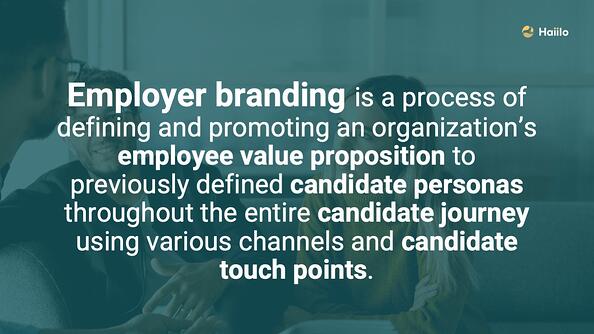
If you are not familiar with all these terms, don’t worry as we will explain them all under the employer brand best practices section.
📚 Check out this comprehensive guide for implementing a successful employer branding strategy.
Why Employer Branding Is So Important
There is plenty of existing research that proves the benefits and power of having a strong employer branding and recruitment marketing strategy. Many employers still think that employer branding is all about attracting new talent to their organizations. Even though this may be a priority for employer branding professionals, EB also plays a big role in engaging and retaining the best talent.
1. Talent attraction
Organizations with better reputations as employers are much more successful in attracting talent to their organizations. Before candidates apply to a certain job opening, they do their research in a very similar way we use when buying a luxury product.
Not convinced? Check out these 2 powerful statistics:
- When making a decision on where to apply for a job, 84% of job seekers say the reputation of a company as an employer is important. (TalentNow)
- 80% of talent acquisition managers believe that employer branding has a significant impact on the ability to hire great talent. (LinkedIn)
2. Employee engagement and productivity
Good employer branding attracts better candidates, resulting in new hires who are more excited about working with you. This then leads to better employee engagement and productivity.
In fact, 49% of companies look at employee engagement as a sign of good employer branding, which is higher than other signs, such as quality of hire (47%).
3. Talent retention
Organizations with a strong reputation are also much better at retaining talent. 92% of people would consider changing jobs if offered a role with a company with an excellent corporate reputation, while LinkedIn research showed that a strong employer brand reduces turnover by an astonishing 28%.
4. Revenue
We all know how expensive it is to replace good people. We also know how expensive and time-consuming it is to advertise job openings and look for new job candidates. Not to talk about the expenses an organization faces with a loss of a senior knowledge worker.
Because of these reasons, 96% of companies agree that employer brand and reputation can positively or negatively impact revenue.
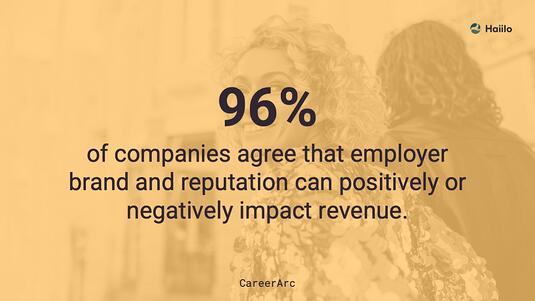
6 Best Practices for Creating a Successful Employer Branding Strategy
Even though employer branding has been around for over 3 decades now, many organizations are still struggling to implement the best practices that result in high ROIs.
The biggest reason for that is the fact that employer branding is still not HR’s priority. Organizations that do have designated employer branding specialists or experts are much better at taking a holistic approach to creating a comprehensive EB strategy.
Let’s take a deeper look into the steps necessary for creating and managing a successful employer branding strategy.
1. Start from within
There are no “quick wins” in employer branding!
There are still too many companies trying to do employer branding while their existing employees are not happy and satisfied. In order to be successful in attracting new people, you first need to make sure that you provide an excellent employee experience.
Hence, the first step in implementing a successful employer branding strategy is assessing your employees’ current experience and job satisfaction. If they are not happy, you need to take a step back and redefine your employee experience strategy.
💡 Check out these 13 tips for improving employee experience in the workplace!
2. Define your EVP
Defining your organization’s employee value proposition is a crucial step that should never be neglected. Defining EVP in employer branding is like defining positioning in marketing.
Yet, only 61% of companies have well-developed EVPs, and 44% of all CEOs don’t even know that their company utilizes EVPs.
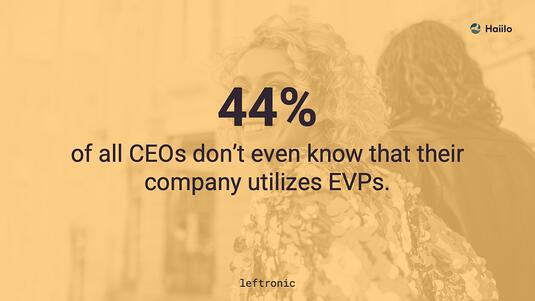
Your organization’s EVP should always answer the question:
“What is it that my organization offers as an employer, and how is that different from other employers who are attracting the same type of people?”
The best way to define the EVP is by interviewing your existing employees to find out what they value about your organization and why do they decide to stay.
These 3 simple questions can really help you understand your employees’ state of mind:
- Why is your company a great workplace?
- What do you value the most?
- Why do you choose to work here instead of somewhere else?
3. Define your candidate personas
The same way marketers define their buyer personas, employer branding professionals should create their candidate personas. Defining ideal candidate profiles help organizations target the right people, create personalized employer branding content, and distribute that content via the right channels.
In most cases, employers define one or more candidate personas per department. When defining candidate personas, these are the main questions to answer:
- What are the candidate’s main skills and interests?
- What is the candidate’s personality?
- What are the candidate’s career goals?
- What is it that frustrates the candidate at work?
- How and where does the candidate look for new job opportunities?
💡 Also check this great candidate persona template!
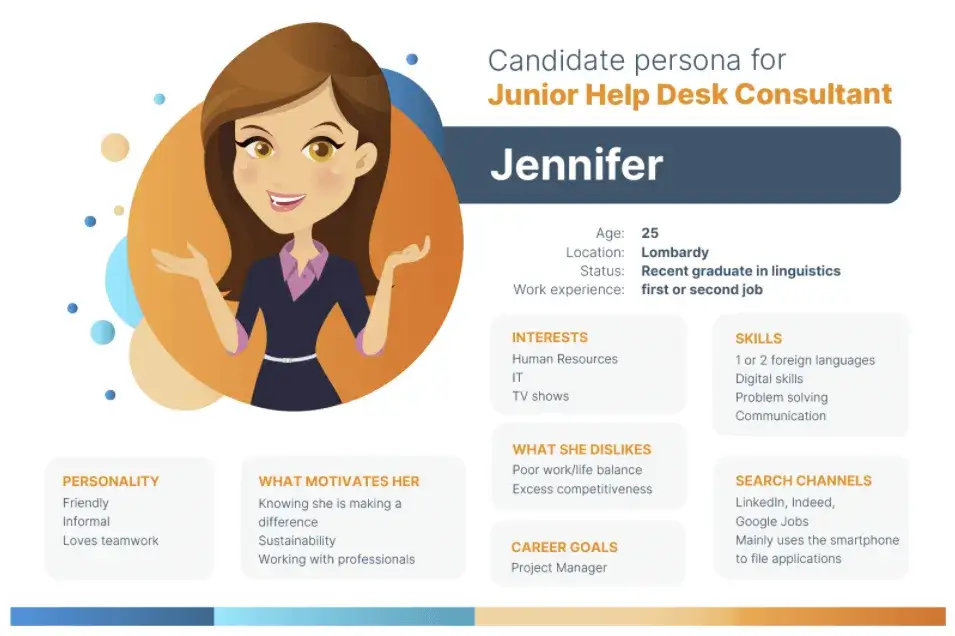
4. Create candidate journey maps and define candidate touchpoints
Employer branding isn’t only about distributing job openings and other EB content to various channels such as social media. It includes many more touchpoints during the selection and hiring process.
In order to deliver an excellent candidate experience, it is important to understand these touchpoints and implement best practices throughout the entire candidate journey. Even if you manage to attract the best talent, you may lose them if you don’t provide a good experience during the job interviews.
Because a positive candidate experience makes candidates 38% more likely to accept a job offer, candidate experience is a crucial piece of every employer branding strategy.
Here is a great candidate journey mapping template that includes the most common candidate touchpoints.
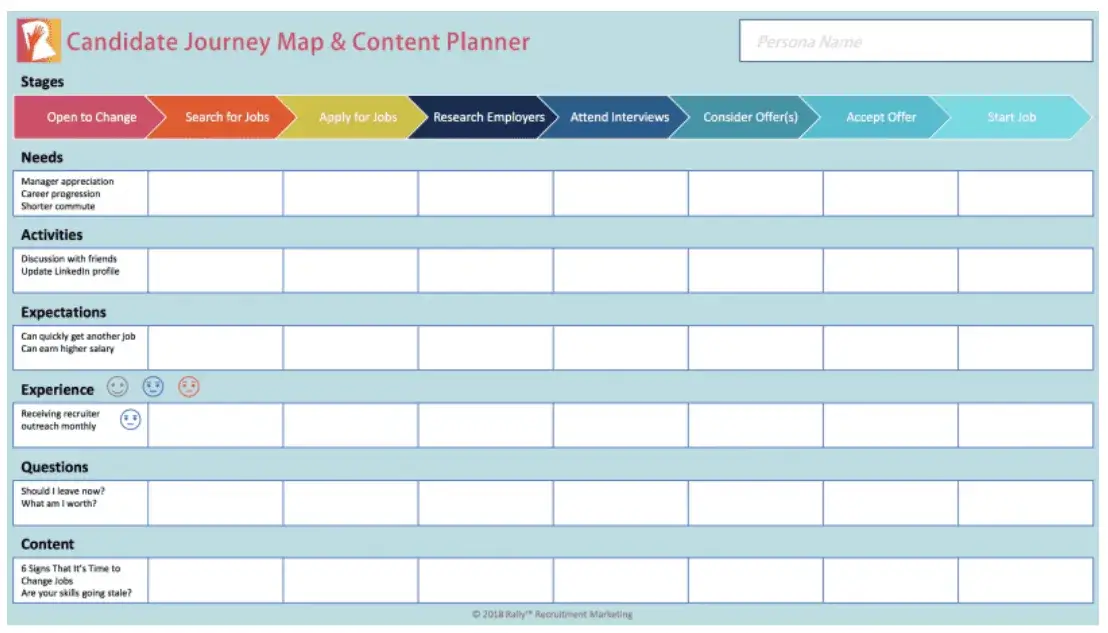
5. Create and distribute engaging employer branding content
Once you define your EVP, candidate personas, and various candidate touchpoints, it is easy to identify and create the right type of content that attracts the right candidates.
Here are some ideas of employer branding content that most candidates find useful:
- Blog posts and webinars about your company events, workplace culture, company hiring process, leadership, career development opportunities, interesting company projects, employee success stories, benefits of working there, etc.
- Social media posts and stories about internal work culture, corporate responsibility initiatives, employee highlights, job openings, etc.
- Video testimonials from employees and even former employees who had a positive and exciting working experience in your organization
- Local job fair sponsorships
💡 Also learn about the importance of social recruitment to attract and hire the best talent out there!
6. Engage your employees
The most successful employer branding initiatives are the ones that involve existing employees. Moreover, without employee advocacy, employer branding becomes a mission impossible.
You need your employees mostly because candidates trust their words more than your CEO’s or brand’s words. You need them to create authentic and engaging employer branding content. And you need them to help you distribute the content and reach a much wider audience.
According to LinkedIn, companies whose employees share their brand’s social content see a lift in the views that their job postings receive.
💡 Learn about how to implement and manage a successful employee advocacy program!
Most Common Employer Branding Challenges
Employer branding is a complex HR discipline that requires various stakeholders to get involved. Let’s take a look into some of the most common challenges organizations face when planning and implementing an employer branding strategy.
1. Limited resources
Compared to marketing and sales, HR departments generally don’t have big budgets besides expenses that cover employees’ compensation and benefits. The fact that 53% of companies would invest more in employer branding if they had bigger budgets says enough about the lack of investments in this field.
2. Lack of employee engagement
One of the biggest challenges employers face in employer branding is the lack of employees’ engagement in EB and recruitment marketing initiatives.
In order to motivate employees to become advocates, they must first be well informed. One study found that a majority (80%) of U.S. employees want to be kept up to speed on company news and happenings, but as much as a quarter of employees don’t feel they’re kept in the loop.
Furthermore, nearly 40% of U.S. employees would be more likely to share company news on social media if they were better informed. This is a missed opportunity to involve employees as brand ambassadors.
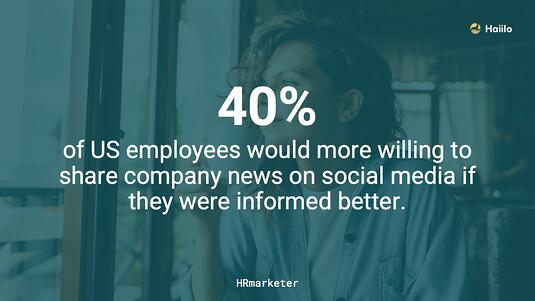
3. Complicated ownership
Who owns employer branding? Marketing, HR, or maybe corporate communications? This is an evergreen question we still don’t have a clear answer to. The best way to think of employer branding is as a discipline that lays between HR and marketing.
While human resources departments are responsible for implementing and maintaining positive workplace culture, core company values, defining EVP and candidate personas, marketing should serve as a support function in creating and distributing employer branding content via the right channels.
Furthermore, internal communications play a crucial role in encouraging and educating employees about how to be brand advocates.
4. Remote work and distributed workforce
With the emergence of remote and hybrid work, employer branding is also changing. Since many organizations have realized that remote work has many benefits, companies are now hiring employees from all over the world.
With that, they need to adjust their employer branding strategies, investigate new employer branding and job advertising channels, get familiar with cultural differences, and implement fully remote selection and onboarding processes.
17 Powerful Employer Branding Statistics to Know in 2022
- 28% Employee turnover can be reduced by 28% by investing in employer branding (LinkedIn)
- 55% of job seekers abandon applications after reading negative reviews online (CareerArc)
- 79% of candidates use social media in their job search. (Glassdoor)
- 50% of candidates say they wouldn’t work for a company with a bad reputation—even for a pay increase (Randstad)
- 86% of HR professionals surveyed indicated recruitment is becoming more like marketing (icims)
- 68% of Millennials, 54% of Gen-Xers, and 48% of Boomers indicated they visit employer’s social media properties specifically to evaluate the employer’s brand (CareerArc)
- 92% of people would consider changing jobs if offered a role with a company with an excellent corporate reputation (HR Daily Advisor)
- A negative reputation can cost a company as much as 10% more per hire (HBR)
- Almost 30% of job seekers have left a job within the first 90 days of starting (indicating misalignment between the candidate and the employer brand) (the muse)
- 78% of job candidates say the overall candidate experience they get is an indicator of how a company values its people. (Talent Adore)
- 96% of companies believe employer brand and reputation can positively or negatively impact revenue, yet less than half (44%) monitor that impact. (CareerArc)
- 80% of talent acquisition managers believe that employer branding has a significant impact on the ability to hire great talent. (LinkedIn)
- The top three channels SMBs plan to extend their employer brand are company website (69%), online professional networks (61%), social media (47%). (LinkedIn)
- 62% of Glassdoor users agree their perception of a company improves after seeing an employer respond to a review. (Glassdoor)
- 49% of employers believe they don’t have the tools to effectively enhance employer brand. (CareerArc)
- 76% of companies choose social media to communicate employer brand. (TalentLyft)
- Employee voice is 3x more credible than the CEO’s when it comes to talking about working conditions in that company. (Edelman Trust Barometer)
Getting Started With Employer Branding
As mentioned earlier, employer branding is impossible with your employees’ buy-in. You need employee-generated content in order to build an authentic and credible employer brand.
When employees are your employer brand storytellers, candidates are much more likely to trust your corporate brand as well.
However, many employers still struggle to motivate their people to engage in employer branding activities and campaigns. Luckily, there are modern tools that make brand advocacy much easier, more intuitive, and more rewarding to employees.









